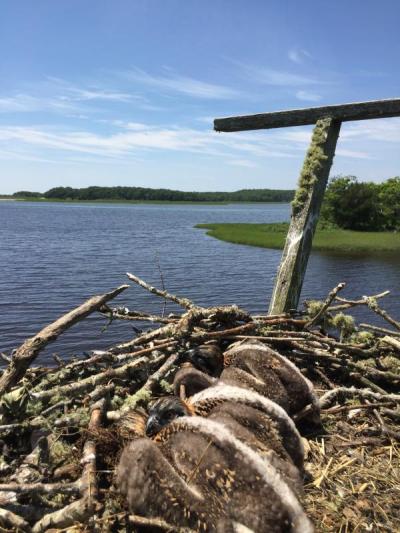Thirty-third Annual Lloyd Center for the Environment Shorebird Season Winds Down by Lloyd Center Research Associate Jamie Bogart
On the morning of July 20, a Lloyd Center for the Environment group traversed Gooseberry Island to witness the first movements of the southward shorebird migration. In addition to a lone grey seal along the western edge of the island where the seals are increasingly common, the usual early migrants were seen. Waterbirds included Common Eider, scoters, Double-crested Cormorants, an Osprey carrying a fish, and a few Common Terns. Shorebird species seen included a large flock of Short-billed Dowitchers, some Ruddy Turnstones, a Willet, and Semipalmated Plovers, close relatives of the Piping Plovers. The appearance of the Semipalmated Plovers is a sure reminder that Piping Plover season is ending, and indeed fledges from our beaches have left their sites to start the southward journey.
This season it can be said that natural predators had the upper hand at both sites, Bakers Beach in Westport and the West Island Town Beach in Fairhaven. At Bakers, this is a difference of only one less fledged chick from 2018, but with only one other pair that ultimately departed the site again after losing the first nest, each fledge is critical. Tracks of coyote and a few crows were seen regularly, so management relative to predators will remain at the forefront. In 2020, the question will be, “how will we manage “the dune pair” which in consecutive seasons lost its clutch then abandoned an exclosed nest?”
At West Island the losses to predation were more substantial. On the town beach, after only one nest was lost last season, five nests were predated and one brood vanished this year. On the Massachusetts Department of Conservation and Recreation (DCR) portion, although five additional pairs is a gain in itself, two to three nests and one to two broods were lost, which is measurable mortality. This is seven to eight total nests and two to three total broods lost on the island this season from the original twelve pairs.
However, the town and DCR portions each fledged three broods, for sixteen to eighteen estimated fledges on the island. This corresponds to a productivity of 1.3 to 1.5 chicks per pair, a decline from last year’s exceptional 2.5 value. The regional productivity required for the plover population to sustain itself is 1.5, so the decline was not catastrophic and productivity remains on track. We also know which predators (coyote and fox) are the biggest culprits, and that prey relationships are ultimately natural cycles where high prey densities attract local predators. More exclosed nests in 2020 are a likely scenario, as the predators will surely return next season.
On other shoreline research fronts, we continued basic monitoring of osprey nesting, and results were mixed this season. On the plus, with the help of the Mass Audubon osprey banding staff, we banded three chicks which hatched from the Lloyd Center platform. This however, was the only one of our four platforms (three on the Slocum River, one on Little River) to produce hatchlings, as nest predation rates for ospreys were also high region-wide. Eerily, in mid-June these platforms were empty. While we highly suspect Great Horned Owl, this is inconclusive. On a particularly sad note, an adult osprey was found deceased close to the traditional platform across the Slocum River at Demarest Lloyd, possibly an adult from that pair. This is the first season where nesting activity ceased at our traditional platform. Cause of mortality of the adult bird is uncertain, but we’ll be watching this platform closely next season to see if a pair returns, and adding predator guard installation to our offseason platform maintenance tasks.
Insect sampling season for “dune affiliates” rolls on in the dune areas of Horseneck Beach, Bakers Beach, and Westport Town Beaches. In addition to moth sampling, pitfalls are now in place at Bakers and Horseneck, and most recently, surveys for both butterflies and bees have started. Initial beetle and bee samples have been salvaged for species identification. For moths, three state-listed species have been discovered in traps thus far. These include the Coastal Heathland Cutworm, Dune Noctuid, and Pink Streak, each of which have been impacted by habitat loss. Butterflies thus far have included the Wood Nymph, Easter Copper, Buckeye, and fabled Monarchs which have started to arrive.
Stay tuned for more detail on findings for the project.
We’re looking forward to another shorebird season next year!











